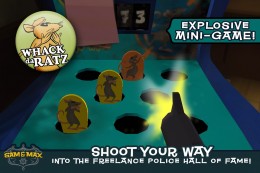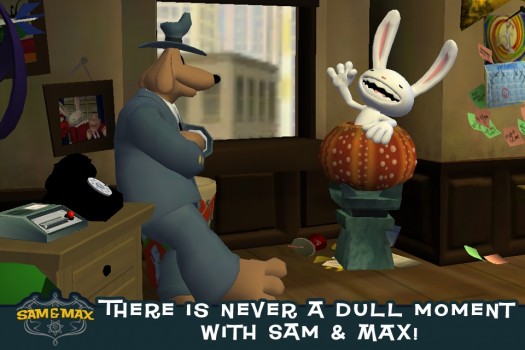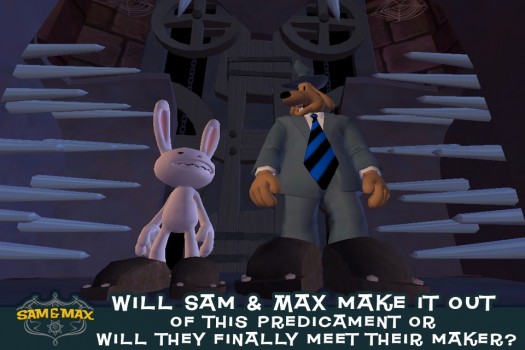![]() The third episode of Sam & Max Beyond Time and Space was originally released in 2008, on the cusp of the videogame industry’s zombie renaissance. Four years and three Dead Risings later the iOS port of “Night of the Raving Dead" [$4.99] may feel — to steal a quote from the game’s antagonist, the vampire Jurgen — “played, yo." Still, Steve Purcell’s brand of silly humor gives “Raving Dead" life, even for those tired of zombies and vampires.
The third episode of Sam & Max Beyond Time and Space was originally released in 2008, on the cusp of the videogame industry’s zombie renaissance. Four years and three Dead Risings later the iOS port of “Night of the Raving Dead" [$4.99] may feel — to steal a quote from the game’s antagonist, the vampire Jurgen — “played, yo." Still, Steve Purcell’s brand of silly humor gives “Raving Dead" life, even for those tired of zombies and vampires.
This season of episodic Sam & Max games comes into its own in “Raving Dead," particularly if players have been keeping up since the first episode “Ice Station Santa" : we can start to see how the central town and its inhabitants are changing over time. We now have access to Sybil’s shop, but Bosco’s Inconvenience has been shuttered since he went missing in the second episode, “Moai Better Blues" ; Flint Paper takes a more active role in “Raving Dead," and Sam and Max have all but stopped giving Stinky the benefit of the doubt in the mysterious death of her grandfather. This is one of the strengths of episodic gaming, and it’s nice to see Telltale Games’ writing come to fruition.
This type of self-referential writings has its limits, though. In-jokes that refer to players’ previous exploits feel natural to players keeping up with the series, but the second quarter of “Raving Dead" can be jarring for those who, like me, didn’t play Sam & Max Save the World. Not that “Raving Dead" is a literary giant, but there are a few levels of nuance in Sam and Max’ relationship with Jurgen that you’ll miss if you didn’t play the “Situation: Comedy" episode from that series, which isn’t currently available on the App Store. And this wouldn’t even be so bad if this plot point didn’t directly inform at least two of the puzzles in the first half of the game.
Nevertheless, “Raving Dead" features the strongest writing and characterization to date — I’ll never forget the way Jurgen hooks his thumbs into his nipple rings while he relaxes.
 Whereas as “Ice Station Santa" and “Moai Better Blues" tend to meander along until a plot twist at the end, “Raving Dead" establishes Jurgen as the antagonist fairly early in the game, and most of the puzzles revolve around him. This gives Purcell room to stretch out and give the game a little more nuance, and I’d even argue that he re-imagines and modernizes the social commentary George Romero wrote into seminal zombie movies like Night of the Living Dead, from where this episode borrows its title. Sam & Max isn’t subtle stuff, by any means, but there are some threads of maturity to be found, not to mention that “Raving Dead" has a relatively bleak ending — I won’t spoil anything here, but it does seem heavy-handed for the series.
Whereas as “Ice Station Santa" and “Moai Better Blues" tend to meander along until a plot twist at the end, “Raving Dead" establishes Jurgen as the antagonist fairly early in the game, and most of the puzzles revolve around him. This gives Purcell room to stretch out and give the game a little more nuance, and I’d even argue that he re-imagines and modernizes the social commentary George Romero wrote into seminal zombie movies like Night of the Living Dead, from where this episode borrows its title. Sam & Max isn’t subtle stuff, by any means, but there are some threads of maturity to be found, not to mention that “Raving Dead" has a relatively bleak ending — I won’t spoil anything here, but it does seem heavy-handed for the series.
This episode is pretty clearly demarcated into two halves, the first of which is probably the most mechanically and thematically interesting of Sam & Max Beyond Time and Space to date. Unfortunately, that praise comes with a caveat: the first half of the game is murky in its goals, and you’ll likely stumble into the puzzle solutions instead of tactfully divining them. There are a few puzzles in particular that, even after having solved them, don’t seem to have much in-game logic behind them — brute force experimentation isn’t as satisfying as actual problem-solving.
 The problem is that “Raving Dead" is narratively strict, often times depending on the player to trigger specific events to push the story forward. In older Sam & Max episodes, players generally had a handful of puzzles to solve at a time, giving them a reason to explore different areas, interact with different characters, and gradually amass the knowledge and items they need to move forward. “Raving Dead" is stingier with its progress, meaning that you’ll need to solve each puzzle in turn before you can move on.
The problem is that “Raving Dead" is narratively strict, often times depending on the player to trigger specific events to push the story forward. In older Sam & Max episodes, players generally had a handful of puzzles to solve at a time, giving them a reason to explore different areas, interact with different characters, and gradually amass the knowledge and items they need to move forward. “Raving Dead" is stingier with its progress, meaning that you’ll need to solve each puzzle in turn before you can move on.
The upshot is that the interplay between Sam, Max, and Jurgen is really neat once you figure it out. Dialogue hints have always been a big part of Sam & Max, but “Raving Dead" is almost impossible to figure out without taking the time to think about Jurgen’s character and motivations. (Again, having played “Situation: Comedy" helps.) Thankfully, the same general idea repeats itself a few times in a row — once you know what makes Jurgen tick and how his castle functions, the game starts to pick up steam in terms of narrative progress and player engagement.
The second half of “Raving Dead" is more straightforward and consists of traditional item management puzzles. The game does a good job of feeding players items, which keeps the game moving forward and pixel-hunting to a minimum. The final boss fight, too, is a return to form after some lackluster fisticuffs against Mr. Spatula in “Moai."
“Raving Dead" ends on a somewhat dour note, but I can’t help be excited at the midpoint of Sam & Max Beyond Time and Space: different plot threads are coming together and the designers at Telltale consistently and effectively iterate on the mechanics and structure of the point-and-click adventure. “Raving Dead" is easily stronger than “Moai Better Blues" and more interesting than, if not executed as well as “Ice Station Santa." Here’s hoping the last two episodes keep up the good work.


